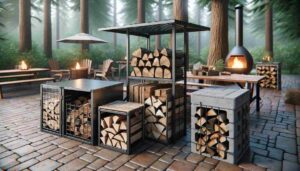Firewood has been a fundamental source of heat, sustenance, and even recreation for humans for millennia. Whether you’re heating your home on a chilly winter evening, grilling a delicious meal in your backyard, or smoking meat to perfection, the type of firewood you choose can significantly impact the outcome. Different wood varieties offer distinct properties that make them suitable for specific purposes.
In this comprehensive guide, we will delve into the world of firewood and help you identify the best types for various needs such as cooking, heating, or smoking.
Understanding Firewood Basics
Before we explore the best types of firewood for specific purposes, it’s essential to grasp the fundamental concepts associated with firewood. Here are some key factors to consider:
- Moisture Content: The moisture content of firewood is crucial. Wet or green wood contains a high percentage of moisture, making it challenging to ignite and less efficient for burning. Seasoned firewood, on the other hand, has been properly dried, usually for at least six months to a year, and typically has a moisture content of 20% or less. Seasoned wood burns hotter and produces less smoke and creosote buildup.
- BTU (British Thermal Unit) Value: The BTU value measures the energy content of firewood and indicates how much heat it can produce when burned. Hardwoods generally have higher BTU values than softwoods, making them a better choice for heating purposes.
- Density: The density of firewood affects its burn time and heat production. Denser woods burn more slowly and produce longer-lasting heat. This can be beneficial for heating applications but less so for cooking or smoking, where a quicker, more consistent burn may be desired.
Now, let’s explore the best types of firewood for various needs:
Cooking
- Applewood: Applewood is renowned for imparting a mild, sweet, and fruity flavor to grilled and smoked foods. It is a popular choice for cooking because of its aromatic qualities. Applewood burns cleanly and evenly, making it ideal for both grilling and smoking. Applewood is especially favored for smoking pork, poultry, and fish.
- Cherry: Cherry wood offers a mild and slightly fruity flavor with a hint of sweetness. It pairs exceptionally well with poultry, pork, and beef, giving your grilled or smoked dishes a delightful, reddish hue. Cherry wood burns consistently and imparts a pleasant, mild smoke flavor to your food.
- Oak: Oak is a versatile cooking wood, known for its ability to enhance the flavors of a wide range of dishes. It imparts a robust and smoky flavor that complements beef, pork, and game meats excellently. Oak burns hot and produces long-lasting coals, making it suitable for grilling and smoking.
- Hickory: Hickory is renowned for its strong, bold, and slightly sweet flavor. It’s a go-to choice for smoking meats, particularly pork and ribs, as it adds a rich, smoky taste to the food. Hickory can be overpowering when used in large quantities, so it’s best to use it sparingly.
- Pecan: Pecan wood offers a milder version of hickory’s flavor, with a sweet and nutty undertone. It’s an excellent choice for smoking poultry and pork, as it imparts a delicate yet flavorful smoke profile. Pecan wood burns consistently and doesn’t produce an overpowering smoke.
Heating
- Oak: Oak is one of the top choices for heating purposes. It has a high BTU value and dense wood that allows for long, sustained heat output. Oak’s slow-burning characteristics make it a reliable source of warmth during cold winter months.
- Maple: Maple wood is another excellent option for heating your home. It burns evenly and produces a steady, moderate heat. The sweet aroma it releases as it burns can add a pleasant ambiance to your living space.
- Cherry: Cherry wood, besides being great for cooking, also provides a decent heat output. It has a moderate BTU value and burns well in wood stoves and fireplaces. The added benefit is the pleasant fragrance it emits when burned.
- Birch: Birch wood is known for its easy ignition and bright, hot flames. While it burns quickly compared to denser hardwoods, it can still provide a good source of heat. Birch is a great choice for kindling or mixing with slower-burning woods.
- Ash: Ash wood is prized for its clean and consistent burn. It produces a high amount of heat and leaves behind very little ash residue. Ash is a reliable choice for heating, and it’s easy to split and handle.
Smoking
- Mesquite: Mesquite is a popular choice for smoking, especially in southwestern cuisine. It imparts a strong, earthy, and slightly sweet flavor to grilled and smoked foods. Mesquite burns hot and fast, making it suitable for shorter smoking sessions.
- Pecan: Pecan wood, in addition to its culinary uses, is excellent for smoking. It offers a mild and nutty flavor that enhances the taste of meats, poultry, and seafood. Pecan wood is versatile and can be used for both short and long smoking sessions.
- Cherry: Cherry wood’s sweet and fruity flavor also makes it a great option for smoking. It complements a variety of meats and adds a beautiful color to your smoked dishes. Cherry wood burns at a moderate pace, making it suitable for different smoking durations.
- Oak: Oak, with its robust and smoky flavor, is a reliable choice for smoking meats. It can provide a rich, well-balanced smoke profile for beef, pork, and game meats. Oak’s slow-burning properties make it suitable for longer smoking sessions.
- Applewood: Applewood, known for its mild and sweet flavor, is excellent for smoking poultry, pork, and fish. It imparts a gentle, fruity aroma to your food without overwhelming it. Applewood’s consistent burn makes it suitable for smoking over extended periods.
Storage and Preparation
Regardless of the type of firewood you choose, proper storage and preparation are essential to ensure its effectiveness for your specific needs.
- Seasoning: If you intend to use firewood for cooking, heating, or smoking, it’s crucial to season the wood properly. This involves allowing it to dry out for an extended period, usually six months to a year, in a dry and well-ventilated area. Seasoned wood burns more efficiently and cleanly.
- Storage: Store your firewood in a covered, well-ventilated area to protect it from moisture and pests. Elevated firewood racks or storage sheds are ideal for this purpose. Keep the wood off the ground to prevent it from absorbing moisture.
- Size and Splitting: The size of the firewood logs matters, especially for heating purposes. Smaller, split logs ignite more easily and burn efficiently. Use a maul or splitting axe to cut larger logs into manageable sizes.
- Safety: When using firewood for cooking or heating, prioritize safety. Install smoke detectors and carbon monoxide detectors in your home, and have a fire extinguisher on hand. Ensure your fireplace or wood-burning stove is properly maintained and inspected regularly.
Conclusion
Identifying the best type of firewood for your specific needs, whether it’s cooking, heating, or smoking, can significantly enhance your experience and results. Understanding the characteristics of different wood varieties, such as moisture content, BTU value, and density, is key to making the right choice.
For cooking, woods like apple, cherry, oak, hickory, and pecan offer a range of flavors to enhance your dishes. When it comes to heating, oak, maple, cherry, birch, and ash are reliable choices, providing steady and efficient heat. Smoking enthusiasts can experiment with mesquite, pecan, cherry, oak, and applewood to achieve the desired flavor profiles.
Remember that proper storage, seasoning, and safety precautions are essential aspects of working with firewood. With the right knowledge and preparation, you can make the most of this timeless resource to cook, heat, and smoke with confidence and satisfaction. So, go ahead, gather your preferred firewood, and embark on a journey of warmth, flavor, and culinary delight.









